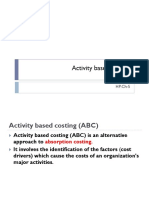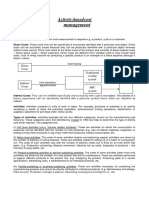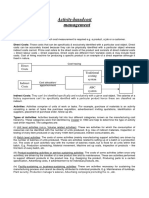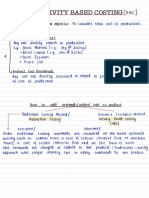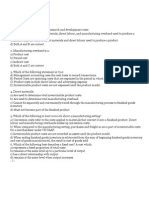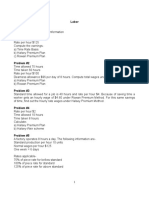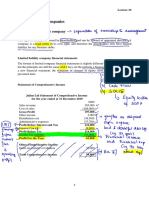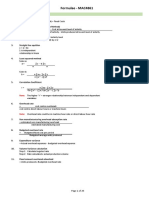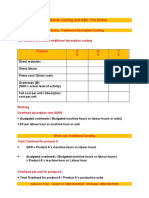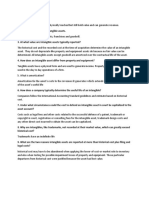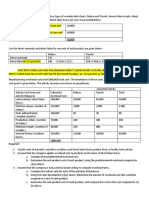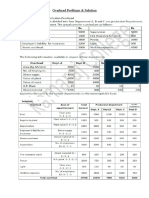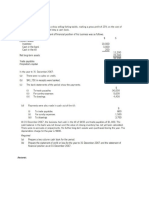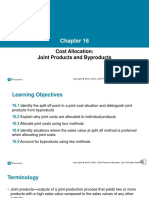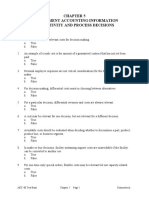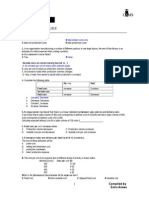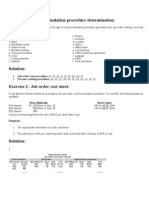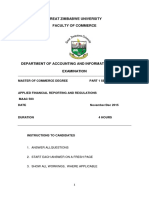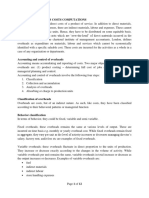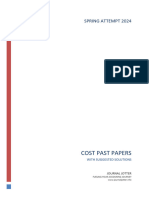0 ratings0% found this document useful (0 votes)
451 views36 pagesABC Costing Notes
Uploaded by
Muhammad FaizanCopyright
© © All Rights Reserved
We take content rights seriously. If you suspect this is your content, claim it here.
Available Formats
Download as PDF or read online on Scribd
0 ratings0% found this document useful (0 votes)
451 views36 pagesABC Costing Notes
Uploaded by
Muhammad FaizanCopyright
© © All Rights Reserved
We take content rights seriously. If you suspect this is your content, claim it here.
Available Formats
Download as PDF or read online on Scribd
You are on page 1/ 36
WHAT’S WHAT OF ABC ?
The activity is the work that is done.
The resource is what the activity uses to do the work.
The cost of the activity depends on the quantity of
resources used to accomplish the activity.
The cost driver for an activity is the factor that influ
the amount of the resources that will be consu
activity.
The activity driver measures how much of,
used by the cost object.
The cost object is whatever it is you wish to cost
be a product, service, process, job or customer. ¢ N :
a, RY
Scanned by CamScanner
Scanned with CamScanner
Activity Based Costing (ABC)
ABC isa
ABC is designed to “good Sipplement
provide managers with to our traditional a
cost information for ey
strategic and other
decisions that
potentially affect
capacity and therefore
affect fixed as well as
variable costs.
2
\asreg, )
Merton
Scanned by CamScanner
Scanned with CamScanner
How Costs are Treated Under
Activity—-Based Costing a
Traditional Costing
The predetermined
overhead rate is based
on budgeted activity.
This results in applying
all overhead costs
including unused, or
idle capacity costs to
products.
@ ABC bases level of activity on capacity.
aq in five WayS:
ABC
Products are charged
for the costs of
capacity they use —
for the costs of
capacity they don’t
use. Unused capacity
costs are treated as
period expenses.
not
Scanned by CamScanner
Scanned with CamScanner
Aaivity Bose _certing
Sole pa 72
less mM ataial
keh our
Vari able
Other oven}
snl VANE A
© Maching tast dvethencl
v Engineering ig Oveibgen cd
vw SA up ove hecxof :
/ In spe chien aVesheaA
Mime ——_— —.
Fradiional Couinp 7
Rin
ete So FY
les matsiat
“feb our :
Oe ovehead overall
—— |
Scanned by CamScanner
Scanned with CamScanner
How Costs are Treated Under
Activity-Based Costin
"Best practice” ABC fers rom radonal costing #49 WY:
‘Best practice” ABC differs from traditional © costing in
ABG
Traditional
product costing
Scanned by CamScanner
Scanned with CamScanner
Preparation of ABC pipauct prottabity report
= i fobs ds
The next step is to compute the Activity Cost Driver Rate
(ACDR).
|The ACDR is the amount determined dividing the activity
expenses by the total quantity of the activity cost driver.
Activity-Based | losting r
Finally, ABC Products Profitability Report is prepared. It
_combines activity expenses assigned to each product with their
‘direct (labour and material) costs.
The activity expenses assigned to a product is arrived at|
multiplying the ACDR by the quantity of each activity cost,
(driver used by each product.
Scanned by CamScanner
Scanned with CamScanner
Tracing Costs from Activities to Products
| Transaction ue
Transaction drivers are used to count the frequency of an
activity/the number of times an activity is performed.
Duration drivers represents the amount of time required
to perform an activity.
are “used to charge directly for
Intensity drivers”
each time an activity is performed.
the resources used
Scanned by CamScanner
Scanned with CamScanner
TRADITIONAL COSTING VS ABC
> traditional cost accounting it is assumed that cost objects
consume resources whereas in ABC it is assumed that cost
objects consume activities.
Traditional cost accounting mostly utilizes volume related
allocation bases while ABC uses drivers at various levels.
Traditional cost accounting is structure-oriented whereas ABC
is process-oriented.
Scanned by CamScanner
Scanned with CamScanner
Step 1: Identify
Resources
Step 2: Identify
Activities
Step 3: Identify
Cost Objects
Step 4: Determine
Resource Drivers
Step 5: Determine
Cost Drivers
STEPS
INVOLVED
Scanned by CamScanner
Scanned with CamScanner
~ Cost
Customer Pools
Order Processing
Material Planning/Acquisition
|
Cost Drivers
No. of customers
No. of order source (customer Noeation
No. of orders by quantity
No. of by value
No. of customers visits aa
No. of items/parts/components ay
No. of deliveries m
No. of material receipts
No. of material orders
No. of material movements
No. of stock shortages/discrepancies
No, of material transactions
Weightvolume of materials
No. of material movements
Scanned by CamScanner
Scanned with CamScanner
VVSLFOOIS
\ \nspection and Quality Control No, of inspecti Cost er
rt cllons
Production Control
Maintenance
Research and Development
Customer Service
Customers Accounting
No. of rejects
No, of Teceipts
No. of parts/volume
No. of customers
Balch sizes
No, of product changes
No. offset-ups
No. of suppliers
No. of product changes
No. of parts Operational
No. of production hours
No.of machine changes
No, of order board changes
_| No. of personnel supervised
No. of schedule changes
“| No.of machine layout changes
No. of production batches
No. of set-ups
No. of work orders
No. of set-ups
No. of machine break-downs:
Capital expenditure
«| No. of defects
No. of toot changes
‘Activity levels A
No. of product changes
No. of production hours
No. of engineering changes
Maintenance schedule
No. of research projects
Personnel hours on a project.
Technical complexities of projects
No. of services calls 5
lo. of products serviced
Ms ‘of hours spent_on servicing pro.
No, of despatches
No. of deliveries
Jo. of invoices:
te ‘of accounting reports
No, of sales orders
ee ed
Scanned by CamScanner
Scanned with CamScanner
SUestion # log ' Products
XYL YZT ABW
(000) (008) ¢000)
Sales and production (units) 50. 40 30
()
» Selling price (per unit) So os 3
Prime cost (per unit) 32 Bd 6S
Hours Hours Hours
Machine departinent 7
(machine hours per unit) -
Assembly department _ 3 2
Greet labour hours
Per unit)
Overheads allocated and eppoitioned to production
der
Partments (including service cost centre cbsts)
‘were to be recovered in product costs as follows:
Machine department at
+ £1.20 per machine hour
Assembly department at
£0.825 per direct labour hour
‘You ascertain that the above overheads could be re+
Analysed into ‘cost pools’ as follows:
Quantity *
for the
Cost pool £000 Cast driver period
rd
+ Machining 387 Machine hours 429000
services :
Assembly 318 Direct labour $3000
services hours
Setup costs: 26 Set-ups 520
Order processing 156 Customer orders 32000
Purchasing _84 Suppliers’ orders - 11 200
9a,
You have also been provided with the following
estimates for the period:
Products
XY YZT ABW
‘Number of get-ups 120-200 200
‘Customer orders 9000 8000-16000
_Suppliers* orders 3000-4000 @ 4200
eres prefer cone t
Scanned by CamScanner
Scanned with CamScanner
SA4e. fe unit us ay 2
es. Prime Cast Paronif 3.2. BY os
cim fe anit tS H+ “G
X_ BL vodume
uniP SOO Wa
20)
otal Crbibrtin margin SSaan
Ybb4a0 _alig.wp
ley DVehe
machine Dp, it ovsheaa as ey
(enochine Pee ubid ot oabccd 120,060 |e Ihtaon \
a nanan unk} 290) eh | Bow || 59 sry _|
: a
poset RU TASO —TaTan 85a
Scanned by CamScanner
Scanned with CamScanner
— ABC Parfit Catintrt
«cag
2Y7r Tr We
08" ‘a ae
Gotet Cim 680 Gly p 226
less avabeadls
machine Rept
Overhead | RS a) ye
Accembly Defrt
Diche,, tl R10 Jz RY4
set-up Ca & 76 10
idler Dike Kir seal 34 Fe
fated Sr-$—e Qype
PrAT ay eS 4
Scanned by CamScanner
Scanned with CamScanner
Waking Ei Paal_overh oy ead (a 5}
fa machine _~ 98 Jo =
OBS pay _marclyre four:
t
6e6VICe
L124) an.
a Aceh See 0:60 Per pired Apo toy.
Seevico $3000
Pep celui cit « 240m
OP Leth co}
fc ISOOTD 9D Per Cu
fer ceded Pwrasing < ee a¥2S Pr Cuda,
ger Puychasing cach = Quay 9S Per tuppyier
12a tae
ab ove Los
yf af Abi
WN umby q Je-up Ne 24. 2m
x x
Az $0 Lecsckup wt Co Ta eo
—- — —
A 6660 len lan,m |
Custom ova Ya Yon Ban
Pec_cuslome nis __. 2269-996
Scanned by CamScanner
Scanned with CamScanner
ng
.1 Example: Activity based costi
2.1 Examp! Y and Z. Output and cost data for the periog jy.
‘Suppose that Cooplan manufactures four products, W, X,
ended are as follows. nuombar of
yroduction '
a inthe Material cost Direct labour Machine
Output units period per unit hours per unit — hours per unit
$
w 10 2 20 i 4
x 10 2 80 8 ;
¥ 100 5 20 1
z 100 5 80 3 3
u
Direct labour cost per hour : $5
Overhead costs $
Short run variable costs 3,080
Set-up costs 10,920
Expediting and scheduling costs 9,100
Materials handling costs 7,700
» — 30,800
Required
Prepare unit costs for each product using conventional costing and ABC.
Solution
Using a conventional absorption costing approach and an absorption rate for overheads based on either
direct labour hours or machine hours, the product costs would be as follows.
Ww x yy zZ “Total
$ $ $ $ $
Direct material 200 800 2,000 8,000
Direct labour 50 500 1,500
Overheads * 700 7,000 “21,000
950 9,500 44,000
Units produced 10 “100
Cost per unit $95 $305 $95
* $30,800 = 440 hours = $70 per direct labour or machine hour.
Scanned by CamScanner
Scanned with CamScanner
Using activity based
eae ae hapa) at He ed of production runs is the cost driver for set-
ts h material it
cost driver for short-run variable costs, unit costs would eae eae ea
w
: $ e y Zz Total
Direct material 200 io § s
aaa ot 50 150 ‘500 ‘ts00
jort-run variable overheads (W1) 70 210 700 2,100
Set-up costs (W2)_ 1,560 1,560 3,300 31900
Expediting, scheduling costs (W3) 1,300 1,300 3.250 3.250
Materials handling costs (W4) i : 2.750
21,500 44,000
Units produced 10 100 100
Cost per unit $612 $131 $215
Workings
1 $7 per machine hour
2 $780 per run
3 $650 per run
4 $550 per run
Summary .
Conventional costing ABC Difference per Difference in
Product unit cost unit cost i i
$
: + 428 +333 43,330
, 305 512 +207 42,070
: e 431 +36 43,600
i 218 90 9,000
z
The figures suggest that the traditional volut
(a) It under-allocates overhead cos!
overheads to higher-volume pro
(b) It under-allocates overhe:
work needed per unit) and
ts to low-volume products (here,
ducts (here Zin particular).
ad costs to smaller-sized products (here W and Y
over allocates overheads to larger products (here
me-based absorption costing system is flawed.
Wand X) and over-allocates
with just one hour of
X and particularly Z)-
Scanned by CamScanner
Scanned with CamScanner
Traditional costing (v) ABC
£ Question:
lhe same equipment and similar process¢
manufactures two products, L and M, using t aye
pesciurit production data for these products In one period is shown below.
extract of the con /
Quantity produced (units) , ql 7,000
Direct labour hours per unit 3 i
Machine hours per unit 40 a
Set-ups in the period ie :
Orders handled in the period
Overhead costs §
Relating to machine activity 220,000
Relating to production run set-ups 20,000
Relating to handling of orders 45,000
285,000
Required
Calculate the production overheads to be absorbed by one unit of each of the products using the following
costing methods.
(@) _ Atraditional costing approach using a direct labour hour rate to absorb overheads
(b) An activity based costing approach, using suitable cost drivers to trace overheads to products
(a) Traditional costing approach
Direct labour
: hours
Product L = 5,000 units x 1 hour 5,000
Product M = 7,000 units x 2 hours 14,000
19,000
= $285
19,
= $15 per hour
.. Overhead absorption rate
Overhead absorbed would be as follows.
Product L 1 hour x $15 = $15 per unit
ProductM 2 hours x $15 = $30 per unit
Scanned by CamScanner
Scanned with CamScanner
(b) ABC approach
Machine hours
Product L = 5,000 units x 3 hours 18,000
Product M = 7,000 units x 1 hour
Using ABC the overhead costs are absorbed according to the cost drivers.
$
Machine-hour driven costs 220,000 + 22,000 m/chours = $10 per m/c hour
Set-up driven costs 20,000. + 50 set-ups 3400 per set-up
Order driven costs 45,000 + 75 orders = $600 per order
Overhead costs are therefore as follows.
Product L Product M
$ $
Machine-driven costs (15,000 hrs x $10) 150,000 (7,000 hrs x $10) 70,000
Set-up costs (10 x $400) 4,000 (40 x $400) 16,000
Order handling costs (15 x $600) 9,000 (60 x $600) 36,000
Units produced 5,000
Overhead cost per unit $32.60
These figures suggest that product M absorbs an unrealistic amount of overhead using a direct
labour hour basis. Overhead absorption should be based on the activities which drive the costs, in
this case machine hours, the number of production run set-ups and the number of orders handled
for each product.
Scanned by CamScanner
Scanned with CamScanner
10.6* Intermediate: Comparison of traditional
product costing with ABC
Having attended ‘a CIMA course on activity-based
costing (ABC) you decide to experiment by apply-
ing the principles of ABC to the four products
currently made and sold by your company. Details
of the four products and relevant information are
given below for one period: :
Product A.B ¢ Dd
She Eee
Output in units 120 100 80 120
Costs per unit: @):...€° &). . ©
Direct material — a0) 50 40 | 00
° Direct labour ~ 283.22) eil4-s: 21
Machine hours (per unit) 4 88202! 3
. The four products are similar-and are usually
produced in production runs of 20 units and sold
in batches of 10 units. _ $
The production overhead is currently absorbed
by using a machine hour rate, and the total of the
+production overhead for the period. has been
-analysed as follows:
‘
@)
“Machine department
Costs (rent, business
Tates, depreciation : 10430
/ and supervision) i as
Set-up costs ‘wae aah 4c 5250 -*
Stores receiving - 3.600
» Inspection/Quality control == «22: 100
~ Materials handling and despatch 4620 -
Scanned by CamScanner
Scanned with CamScanner
You have ascertained that the “cost drivers’ to be ]
_ used are as listed below for the overhead costs |
shown: _ :
Cost Cost Driver
Set up costs Number of production
runs
Stores receiving _ Requisitions raised
Inspection/Quality control Number of production
: runs
Materials handling Orders ‘executed
and despatch
+ The number of requisitions raised on the stores was
20 for each product and the number of orders
~ executed was 42, each order being for a batch of
10 of a product. You are required
(a) to Calculate the total costs for each product if
all overhead costs are absorbed on a. machine
_ hour basis; : ' ” (4, marks)
(b) to calculate the total costs for each product,
_ “using activity-based costing; (7 marks).
(c). to calculate and list the unit, product costs,
from your figures in (a) and (b) above, to show
- the differences and to comment briefly on any
“conclusions which may be drawn which could
= ici d profit implications. :
- have eee an P ae)
(Total 15 marks)
Scanned by CamScanner
Scanned with CamScanner
1120 x 4 hrs) + (100 x 3 hrs) + (60 X 2 hrs) + (120 x 3hrs) Question 10.6
1300 hrs.
£10 430 + £5250 + £3600 + €2100 + £4620
Machine hour overhead rate = Ts00ke
= £20 per machine hour
Product A B c D
© © © ©
Direct material 40 50 30 60
Direct labour 28 a 4 2
Scanned by CamScanner
Scanned with CamScanner
i 80 0 40
Overheads at £20 per machine hour a ¢@ 2 «
: 20 100) ay
Units of output £17760 £13100 £6720 gyn)
Total cost
Cost driver Cost driver Cost per
(e) Costs transactions — unit
© ©
10430 Machine hours 1300 hours 8.02
Machine department 5250 Production runs 21 250
Set-up costs | 3.000 Requisitions,raised 80 (4 * 20) 6
Stores receiving antral 2100) Production 1uns 21 109
Inspection/quanly Number of orders
Materials handling executed 42 no
Pate : = ut (420 snits)/20 units per set-up.
Number of production runs = TO) OOP 9p units)/10 units per order.
Number of orders executed = To!
The total costs for each product a
re computed by multiplying the cost driver rate
t driver consumed by each product.
per unit by the quantity of the cos!
A B (ey D
Prime costs 8 160 (£68 X 120) 7100 3520-9720
Set ups 1500 (£250 x6) 1250 (£2505) 1000 1500
Stores/receiving 900 (£45 x 20) 900 3900 900
Inspectiorvquality 600 (£100 x 6) 500 400 «600
Handling despatch 1320 (£110 x 12) 1100 (£110 10) 880-1320
Machine dept cost* 3851 2407 1284 2888
Total costs 16331 13257 7984 16928
Note
*A = 120 units x 4 hrs X £8.02; B = 100 units x 3 hrs x £8.02
(©) Cost per unit
Costs from (a) 148.00
Costs from (b) i 131.00 $4.00 141.00
Difference 13257 99.80 141.07
(11.91) 157 15.80 0.07
Product A is over-costed with the
Costed and similar costs are re}
accurately measures resoure
used, the transfi
activity-based ‘costs are
; us
. eported profits wil differ
for stock
traditional system. Products B ‘
ti . and C are under
Ported with Product D. It is claimed that ABC more
relying on misleading Product coat ne by produets (see ‘Errors arising fi rom
fet to an ABC system ogi spect 10). Where cost-plus pricing s
" resale in different product prices. !!
aluations then stock valuations an!
Scanned by CamScanner
Scanned with CamScanner
Qi \ (PTTL RON:)
A company plans to experiment activity based costing (ABC) by appl its
principles to its four products. Details and relevant information are given below for
a particular month:
eee
Products Wor oY 2 I'D
80120 = S
Output in units (720 100 20.
Cost per unit : Rupees
~~ Raw material 4—~ nn)
Direct labour 21 14 a
“Machine hours per unit Ao 3 2 =
All the products are similar and usually manufactured in production uns. of. 20 units
ntly absorbed by
and sold in batches of 10 units. Manufacturing overhead is curre!
using a machine hour rate of Rs. 20 per hour. Total overhead forthe month and
cost drivers To be used are as follows:
Manufacturing overhead ‘Amount (Rs) __cost driver to be used
Machine department cost 10.430 :
Set-up costs 57250 Number of production runs
Stores receiving 3,600 Requisitions raised
Inspection/ quality control 2,100 Number of production runs
Materials handling and despatch 4,620 Orders executed
Number of requisition raised on the stores was 20 for each product and number of
orders executed was 42. Each order has a batch of 10 units.
Required: :
Calculate thé following:
i)" Total cost for each product, if all overhead costs are absorbed on machine
hour basis. : 3 - ; 02
(i)___Menufacturing overhead cost per unt,“ os od
(iit) Fotai cost for each product, using ABC.approaciS—— 06
Solution: fs : oat
(i) Total cost of each product if overhead costs are absorbed on machine hour:
Product: WW - x y, Zz
Raw material ~ 40 50 “30 60
Direct labour’ f 24 14
—Dverhead at Rs. 20 perhour 60 40 60
7 ‘ost per units ~~ 148. 131 84 =
vg ~Gutput in units 129 - 100 80 ‘2
o ~fotal cost 17,760 13,100 ;
oy Sw.
oo rn
Scanned by CamScanner
Scanned with CamScanner
Ww
Manufacturing overhead cost per unit:
° Cost!
Overhead Ri Cost driver
: Costdriver Transactions fm
Machine department cost 110,430 “Machine hours 13000 hours 023
Set-up costs 8,250 Production runs* 2 + 250.000
Stores receiving
: 3,600 Requisitions raised 4x20 =80 45.000
Inspection / quality control 2,100 Production runs” 4 100.000
Material handling and dispatch _4,620_ Orders executed** 42 448.000
No. of production run = 420 units +20 units per set-up = 21 runs
No. of order executed = 420units + 10 units per order = 42 orders
{ill) Total cost of each product using activity-based costing:
‘Material & labour ()
8,160 7,100 3,520
9,720
Set-up costs (2) 1500 1,250 1,000 1,500
Stores receiving (20 at Rs.45) 900 900 900 900
Inspection/quality control (3) 600 500
Mat. Handling and dispatch (4) 1,320 4,100
Machine department cost (5) _3,854 2,407
Totalcost 16,331 13,257
Notes
(4) Cost per unit x output units
a Based on production run‘of 21
Based on production run of 24
(4) Material handling 110 x 12
(8) Output units x machine hours per unit x machine dept. cost per unit.
Scanned by CamScanner
Scanned with CamScanner
A steel manufacturing compan)
; i IP
simple Activity Based Costing (ABC
pools and activity measures:
Activity cost pool
Assembling units.
Processing orders
Supporting customers
Others Not applicable
The company has two types of overhead with following
Production overhead
Selling and administrative overhead
Total overhead costs
ES
‘oduces filing cabinets. The company has @
) system which has the following activity cost
Activity measures
Number of units
Number of orders
Number of customers
cost break-up:
Rs. 000"
2,000
“4,200-
iw
3,200
34
any allocates the overhead cost to the activity cost pools on following
The comp:
basis:
Distribution of Resource consumption Across [Assembling Processing Supporting | others
Activity Cost Pools Units Orders | Customers
0
Production overhead % \ 50% 35 = oy i ef
Selling and administrative overhead %. 1 45 25 al
7000 | 250 400
Total activity units orders | customers
filing cabinet
jling price of @
ae Rs. 720 an
direct labour are
ordered 80 cabine
id Rs.
is Rs. 2,380. Per unit cost of direct materials and
260 respectively. Last month, a customer
g (in total) at four different times.
Required:
Calculate the following
(i) V “Allocate total overhead costs to the activity cost pools oe
fay Aactivity rates for the activity cost pools =
(iii) Overhead cost attributable to four orders for'80 cabinets te
(iv) Customer margin cs
Scanned by CamScanner
Scanned with CamScanner
Solution: aa
{i) Allocation of costs to the activity cost pools:
Assombing Tt Bs. 000
ssembling — Processing Supporting
Is
~~ Aativity cost poo! Units Orders Customers Uners Total
Production overhead 700~ ~ 10 200° 2,000"
Selling & administrative O.H : _ 540 301 240 1,200
Total overhead costs 11205 1,240 440 3,200
(ii) Activity Rates for the Activity Cost Pools:
x Rs. ‘000"
Total Cost
Total Activity Activity Rate (Rs.)
(Rs.) E __
Assembling units 1,120,060 units 7AN205 per unit
Processing orders 4,240,000 orders 4,960 per order
Supporting customers customers | 4,000 _per customer
{iii) Overhead cost attributable to 4 orders of 80 cabinets
t
1,120 S~ [80 units —~
4 orders
t+ customers
"ABC Gost (Rs.)
—
Assembling units
Processing orders
Supporting customers
iv) Customer Margin: A” /)
(iv) Customer Margin: / C1
Rs.
—
‘Sales (80 units @ Rs. 2,380) 190,400
Less: Costs
Direct material (80 units @ Rs. 720) 57,600
Direct labour (80 units @ Rs. 200) 16,000
Overhead under ABC method: a
Unit related overhead 89,600
Order related overhead 19,840
Customer related overhead 4,000_ |
187,040
Customer margin - 3360
Scanned by CamScanner
Scanned with CamScanner
duct X is produced in two
200 units. Assuming each
tent. The manufacturing
7
F Question No. 17
XYZ Ltd. Company manufactures two Products X and Y Pro
runs of 500 units and Product Y in five independent runs of
product consumes equal direct material and direct labour con' ee
overheads amounts to Rs. 14,000, which comprises of line set-up costs of Rs. 7,000,
product inspection costs of Rs. 3,500 and Rs. 3,500 for material movement to the product
line. Total costs incurred for producing 1000 units of Product X and 1000 units Product Y
Rs.
10,000.
2,000
will be as under:
Direct materials
Direct labour
Manufacturing overhead
Scanned by CamScanner
Scanned with CamScanner
Answer No. 17
Product wise Total Cost unde!
Traditional Costing
Particulars Total | por unit
; cost
00 5,000
Direct materials - e,o0e ‘ 00 1,000
Direct labour ; 1000) Fo] 71
Manufacturing overheads (700% of direct labour) 7,000 :
Total cost 43,000 | 13.00 |
Product wise Total Cost under Activity Based Costing (Rs)
Product X Product Y
Particulars {1.000 Unit) Ti cee san
Total | perunit | 10%! Per unit
cost cost
Direct materials (000 5.00| 5,000 5.00
Direct labour 4,000 1.00] 1,000 1.00
Manufacturing overhead:
Line set-up costs
(Two set-ups; Five set-ups) 2,000 2.00| 5,000 5.00
Product inspection costs
(Two inspections; Five inspections) 1,000 1.00] 2,500 2.50
Material movements
(Two movements; Five movements) 1,000 1.00 2,500 250
10,000 | 10.00 [~ 16,000[- 46.00
Total Cost. -
Scanned by CamScanner
Scanned with CamScanner
Chapter.g2
question No. 16 Pres
eted overheads ang cost dtiver vai
eS OF XYZ Lid; Ay
oat Budgeted ° Are as follows:
Overhead (Rs) | | Cost a
| eames tend a oe ate Budgeted volume
t 350,000 No. of movements
5,000 No. of set-ups
| : Re Maintenance
| K —|.No. of i i
uesomn Of inspections :
No.of machine hours
of 2,600 components of AX-1! 5,.its material cost was,
245,000. The USage activities of the said batch are
company has produced a batch
*30,000 and labour cost was Rs.
S
k al orders - 26
. Maintenance hours
ial movements 18 Inspection
-upS 25°. Machine hours.
Required:
Calculate cost driver rates “that are used for \racing
overheads to the said batch.
5) Ascertain the cost of batch of components using ABC.
(3)
appropriate amount of
(
Scanned by CamScanner
Scanned with CamScanner
answer No. 16 q i
Calculation of Cost Driver Rates
Rs. §80,000/1,100
(a)
Material procurement
Materia! handling
Set-up
Maintenance i
Quality control Rs. 176,000/900
Machine _ = Rs, 720,000/24,000 =. Rs.30
») Calculation Cost of a Batch of 2,600 Components of AX-15 aby
Direct material ti 130,000
Direct labour 245,000
Prime cost 375,000
Add: Overheads ie
Material procurement (26 x Rs. 527)
Material handling (18 x Rs. 368)
Set-up cost ; 5) (25 * Rs. 798)
Maintenance 8 (690 * Rs. 115) k
Quality control (28 * Rs. 195) §
Machine (1,800 * Rs. 30) . 179,086
Balok nnn es & 554,086
Scanned by CamScanner
Scanned with CamScanner
Marks
Q.2 The details of the cost, volume and cost drivers for a particular period in respect of Daata
Textile Limited are as under:
es Product = Allipha Beta Zeta_—‘Total
Production and sales (units) 45,000 35,000 10,000
Sale price (Rs.) 100 110 = 100
Raw material usage (units) 5 5 1"
Direct material cost (Rs./ unit & total) aos 15 2,375,000
Direct labour hours 2 4 2 280,000
Machine hours 2 3 2 215,000
Direct labour cost (Rs./ unit) 12 15 10
Number of production runs 3 7 2 30
Number of deliveries 9 a 20 32
Number of receipts of inventory components 15 35220 270
Number of production orders 5 dO: 25) 50
Overhead cost: Rupees _
Set-up 50,000
Machines 800,000
Receiving 500,000
Packing 300,000
Engineering 400,000
2,050,000
In the past the company has allocated overheads to products on the basis of direct labour
hours, though the majority of overheads are more closely related to machine hours than direct
labour hours.
The company has recently redesigned its costing system for recovering overhead of receiving
department using two volume-related bases: machine hours and a material handling
overhead rate.
Required:
(a) Compute the product-wise profitability using a traditional volume-related costing system
based on:
(i) past practice. 04
(ii) current practice. 04
(b) Compute product-wise profitability using an aclivity-based costing system. 06
(6) Briefly explain the differences between the productwise profitabiliy calculated in
(a) and (b) above.
Scanned by CamScanner
Scanned with CamScanner
Q.2 (a)
(i) Product-wise profitability — past practice:
Total Machine hours
pect labour overhead rate = —--Toaoverheads ___ 2,050,000 5
bea celles Tolal direct labour hours 250,000.
Product cost: Rupees
Product Alpha Beta. Zeta
Direct material 30 25 15
Direct labour 12 15 10
Overhead (W-1) 16 33 16
Total cost 58 73 a
Sale price per unit 100 110 100
Profit per unit 42 37 59
Workings:
Rupees
Bela___Zela
400 2.00
© Per hour rate 8.20 8.20 8.20
s@_Overheads 1640 32.80 _16.40
“(ii)_ Product-nise profitability — current practice:
Receiving department overheads
. . piving
You might also like
- ABC Latest Theory and Practice Questions PDFNo ratings yetABC Latest Theory and Practice Questions PDF18 pages
- Activity-Based-Costing - PAST PAPER QUESTIONSNo ratings yetActivity-Based-Costing - PAST PAPER QUESTIONS14 pages
- ABC Latest Theory and Practice QuestionsNo ratings yetABC Latest Theory and Practice Questions18 pages
- Cash & Receivables (Ch-7) CMA Questions & Solutions100% (1)Cash & Receivables (Ch-7) CMA Questions & Solutions24 pages
- Cost Accounting SEM 5 (Sample Question Paper)No ratings yetCost Accounting SEM 5 (Sample Question Paper)10 pages
- E1 Answer Key Intermediate Accounting II Exam 1No ratings yetE1 Answer Key Intermediate Accounting II Exam 113 pages
- Activity Based Costing Spring 2020 Answers Final - pdf-1No ratings yetActivity Based Costing Spring 2020 Answers Final - pdf-120 pages
- Activity Based Costing and Activity Based Management - ProblemNo ratings yetActivity Based Costing and Activity Based Management - Problem3 pages
- Cash Flow Basics for Accounting StudentsNo ratings yetCash Flow Basics for Accounting Students23 pages
- Management Accounting Model Answers Series 3 2012No ratings yetManagement Accounting Model Answers Series 3 201214 pages
- Labour Costing: Calculation of Wages & BonusesNo ratings yetLabour Costing: Calculation of Wages & Bonuses13 pages
- Management Accounting Information For Activity and Process DecisionsNo ratings yetManagement Accounting Information For Activity and Process Decisions30 pages
- C01 First Test (Classification and Behaviour of Cost)100% (1)C01 First Test (Classification and Behaviour of Cost)5 pages
- Great Zimbabwe University Faculty of CommerceNo ratings yetGreat Zimbabwe University Faculty of Commerce6 pages
- Activity Based Costing Spring 2023 With ThoeryNo ratings yetActivity Based Costing Spring 2023 With Thoery12 pages
- Paper - 3: Cost and Management Accounting: © The Institute of Chartered Accountants of IndiaNo ratings yetPaper - 3: Cost and Management Accounting: © The Institute of Chartered Accountants of India28 pages
- Part 1 - Section D Activity Based CostingNo ratings yetPart 1 - Section D Activity Based Costing42 pages
